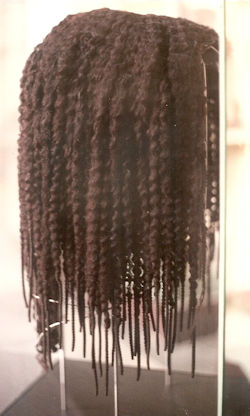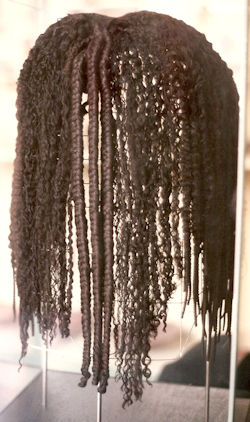* Corresponding author: Department of Archaeology, King's Manor, University of York, YO1 7EP, UK.
Email: sb55@york.ac.uk
Cite this as: Buckley, S. and Fletcher, J. 2016 The Hair and Wig of Meryt: Grooming in the 18th Dynasty, Internet Archaeology 42. http://dx.doi.org/10.11141/ia.42.6.4
As part of a long-term study of the collections of Turin's Museo Egizio, the authors have particularly focused on the contents of the tomb of the 14th-century BC couple Kha and Meryt, discovered intact in 1906 at the workman's village of Deir el-Medina, modern Luxor (Schiaparelli 1927; Vassilika 2010). In addition to the mummies of the couple themselves, which have never been unwrapped, the tomb contained over five hundred items, combining equipment made specifically for burial with items the couple had used in their daily lives.
Among Meryt's belongings were her well-stocked cosmetic chest and items relating to her hairdressing regime — her wig (Figure 1 a-b) and wooden wig box, and two baskets containing her hairpins, razors and wooden combs (Figure 2).


As the most impressive woman's wig to have survived from pharaonic times (Schiaparelli 1927, 101), Meryt's long wig closely replicates the numerous portrayals of the long full 'enveloping' style found particularly in 14th-century BC sculpture and tomb scenes (Fletcher 1995, 260-3). Made entirely of dark brown human hair (Carpignano and Rabino Massa 1981, 229), the original archaeologist Ernesto Schiaparelli claimed that, upon its discovery, Meryt's wig 'still shines with the perfumed oils that were applied to it' ('è tuttora lucent per gli oli profumati di cui era stata cosparsa e', Schiaparelli 1927, 101).

It was created on a foundation base along a long thin plait forming the central 'parting' to which individual lengths of hair were attached at right angles by means of slip knots. To this foundation were attached separate sections of hair approximately 54cm in length, possibly having first been plaited when wet to achieve a 'crimped' effect, and the ends of each section tightly twisted to secure them (Chiotasso et al. 1992, 101; Fletcher 1995, 388). A further braid made up of three thicker plaits was attached at the crown to hang down at the back of the head (Fletcher 1995, 388). Yet during the authors' first examination of the wig in 1994 and again in 2013, it was noted that the quantity of hair employed combined with the distribution of the individual sections of hair along the central parting would not have completely concealed Meryt's head when worn (Figure 1b).
The wig was discovered in a tall shrine-shaped wig box of acacia wood inscribed with Meryt's name, its 110cm tall dimensions allowing the wig to hang freely within when placed over two parallel wooden supports covered by linen that made up the wig mount (Schiaparelli 1927, 101-2). At the bottom of the wig box lay further 'pieces of plaits and clumps of hair' ('frammenti di trecce e batuffoli di cappelli', Schiaparelli 1927, 101), the absence of any visible means of anchoring these plaited lengths to either the wig or natural hair suggesting that they are either incomplete or unfinished hair extensions, or may alternatively have been Meryt's natural hair, collected in life and retained for burial with her, as was regular practice (Fletcher and Montserrat 1998, 406).
There were also two baskets that between them contained a large, carefully folded sheet of fringed linen stained with oil and described as 'Meryt's bathrobe' ('accappatoio', Schiaparelli 1927, 106); further pieces of plaited hair; seven hairpins, four of bronze and three bone; two bronze razors; and three wooden combs; a further comb with broken teeth had been found in Meryt's aforementioned cosmetic chest (Schiaparelli 1927, 109). As a key item of hairdressing equipment employed throughout pharaonic history, ornate combs were sometimes worn in the hair as a form of adornment but were mainly used to keep the hair free of tangles or indeed head lice and their eggs, most easily removed with the fine teeth of such combs and often recovered from between the combs' teeth.
Although Meryt's body has never been unwrapped, a succession of X-rays and CT scans have revealed a broad collar necklace, finger rings, a jewelled belt and two sets of large gold earrings, suggesting each ear had been pierced twice in a fashion restricted to the second half of the 18th dynasty, c.1400-1335 BC (Fletcher 2004, 290, 351). Following recent research, it also appears that, like her husband Kha, Meryt had been mummified in a natron salt solution that had preserved her internal organs in situ while causing her bones to become disarticulated and losing much of the original soft tissue (Bianucci et al. 2015). So in order to gain more detailed information about Meryt's original hairstyle and grooming regime, it was decided to re-examine her wig and comb utilising GC/MS analysis, which requires sample sizes less than 0.1mg (Buckley and Evershed 2001).
Analysis of the lower lengths of hair employed in Meryt's wig (S.8499) revealed the presence of a plant oil mixed with a small amount of 'balsam' (Figure 3a).

Analysis of debris from between the teeth of Meryt's wooden comb (S.8377) found in Meryt's cosmetic chest revealed the presence of a plant oil, a plant gum, a 'balsam' and beeswax (Figure 3b), together with cholesterol.
The discovery of a plant oil mixed with a small amount of 'balsam' on the wig is quite different from the beeswax and resin hair fixative mixture employed in the case of the contemporary man's wig now in the British Museum. It may therefore have served a different purpose, perhaps as a perfumed moisturising treatment to keep the hair in good condition, as in fact was originally suggested (Schiaparelli 1927, 101). In the case of the debris from Meryt's comb, the presence of cholesterol, one of the major compounds found on the human scalp and skin and notably abundant at the root end of the hair, indicates that Meryt had used the comb in life, and, unlike other elite women of the time, had not shaved her head completely (Fletcher 2004, 110, 185), but retained at least some of her own hair. This is also borne out by the style of her wig, which was designed to be worn over some amount of natural hair, albeit kept fairly short presumably by means of Meryt's bronze razors, used to trim hair prior to the introduction of shears or scissors (Fletcher 1995, 442). Meryt may then have combed her own short hair flat, smoothing it down with an application of the plant oil, plant gum, balsam and beeswax mixture that was also found between the comb's teeth.
Although analysis of both Meryt and Kha's possessions is ongoing, these preliminary results demonstrate the way in which appropriate forms of analysis can help interpret patterns of object usage, providing new insight into ancient grooming regimes and accessing an intimate and largely private part of daily life as lived some three and a half thousand years ago.
Bianucci, R., Habicht, M., Buckley, S., Fletcher, J. Seiler, R., Öhrström, L., Vassilika, E., Böni, T. and Rühli, F. 2015 'Shedding new light on the 18th Dynasty mummies of the Royal Architect Kha and his spouse Merit', PLoS ONE 10(7) e0131916 http://dx.doi.org/10.1371/journal.pone.0131916
Buckley, S.A. and Evershed, R. 2001 'Organic chemistry of embalming agents in Pharaonic and Graeco-Roman mummies', Nature 413(6858). 837-841. http://dx.doi.org/10.1038/35101588
Carpignano, G. and Rabino Massa, E. 1981 'Analisi di un campione di capelli della parrucca appartenente alla moglie dell'architetto Kha', Oriens Antiquus 20. 229-230.
Chiotasso, L., Chiotasso, P., Pedrini, L., Rigoni, G. and Sarnelli, C. 1992 'La parrucca di Merit', Sesto Congresso Internazionale di Egittologia I. Turin. 99-105.
Curto, S. and Mancini, M. 1968 'News of Kha' and Meryt', Journal of Egyptian Archaeology 54. 77-81. http://dx.doi.org/10.2307/3855908
Fletcher, J. 1995 Ancient Egyptian Hair: a study in style, form and function. Unpublished PhD thesis, University of Manchester.
Fletcher, J. 2000 'Hair', in P. Nicholson and I. Shaw (eds) Ancient Egyptian Materials and Technology, Cambridge: Cambridge University Press. 495-501.
Fletcher, J. 2004 The Search for Nefertiti. London: Hodder.
Fletcher, J. and Montserrat, D. 1998 'The human hair from the tomb of Tutankhamun: a re-evaluation' in C. Eyre (ed) Proceedings of the Seventh International Congress of Egyptologists. 401-7.
Schiaparelli, E. 1927 La Tomba Intatta dell' Architetto Kha nella Necropoli di Tebe. Turin.
Vassilika, E. 2010 The Tomb of Kha. Firenze: Scala Group.
The comments facility has now been turned off.
Internet Archaeology is an open access journal based in the Department of Archaeology, University of York. Except where otherwise noted, content from this work may be used under the terms of the Creative Commons Attribution 3.0 (CC BY) Unported licence, which permits unrestricted use, distribution, and reproduction in any medium, provided that attribution to the author(s), the title of the work, the Internet Archaeology journal and the relevant URL/DOI are given.
Terms and Conditions | Legal Statements | Privacy Policy | Cookies Policy | Citing Internet Archaeology
Internet Archaeology content is preserved for the long term with the Archaeology Data Service. Help sustain and support open access publication by donating to our Open Access Archaeology Fund.